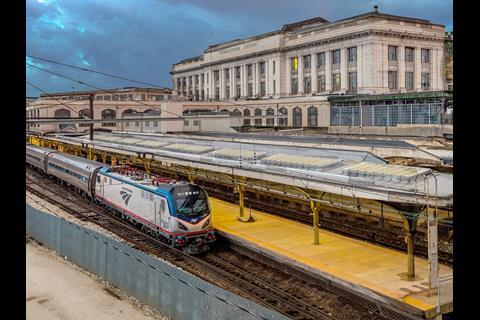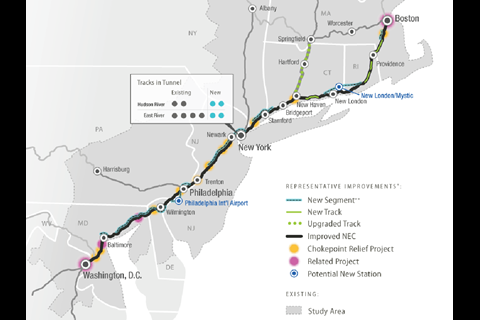USA: The Federal Railroad Administration on July 12 released a Record of Decision marking completion of a Tier 1 environmental review of the Northeast Corridor under the National Environmental Policy Act.
This establishes a long-term planning framework for the 735 km corridor linking Boston with Washington DC, along which a series of route enhancement, renewal and new alignment projects are now being developed under the NEC Future programme. NEC Future is being co-ordinated by FRA, bringing together the various states, government agencies and railway operators which own and use the corridor.
FRA is seeking to identify ways to ‘improve the reliability, capacity, connectivity, performance and resiliency’ of NEC passenger services over the period to 2040 and beyond. It says ‘the approximate total cost estimate for all projects within the parameters of the ROD is between $121bn and $153bn’.
According to FRA, the ROD establishes ‘agency relationships and agreements that will expedite and coordinate environmental reviews’, and seeks to narrow the range of possible investment alternatives that would need to be examined as the programme develops. The ROD also allows priority projects to move forward more rapidly, because the Tier 1 environmental review process will already have been completed.
The ROD also confirms the menu of potential options to enhance passenger services which had been previously identified by FRA in December 2016. These include:
• increasing capacity to enable a doubling of commuter services and up to five times more long-distance trains;
• accelerating inter-city journeys between Boston and New York by up to 45 min and between New York and Washington DC by 35 min;
• remodelling the NEC alignment to create a largely four- and six-track alignment capable of handling the projected growth in inter-city and commuter rail traffic to 2040 and beyond;
• adding around 320 route-km of ‘expanded track capacity’ between Washington, DC and New Haven, and between Providence and Boston;
• improving the passenger experience though investment in ticket retail, station amenities and connections with local transport modes;
• stipulating that any new alignments should as far as possible be designed for operation at up to 355 km/h to support development of a purpose-built high speed line in the longer term;
• calling for a New Haven/Providence Capacity Planning Study to identify on- and off-NEC infrastructure to address capacity constraints, speed restrictions and flooding vulnerability along the Connecticut and Rhode Island coastline.
‘Given the high cost projections of the recommendations in the NEC ROD and the reality of state budgets, the completion of the Tier 1 study will enable states to better prioritise which projects to pursue’, said FRA Deputy Administrator Heath Hall. ‘Through this effort, localities will have a clearer picture of how their projects will fit in with the rest of the Northeast Corridor.’
The ROD assumes that by 2040, ridership will grow by around 70% at New York Penn Station, by more than 80% at Washington Union and by 50% at Boston South. It does not include funding recommendations to implement the suggested improvements, ‘in recognition that those decisions must be made by local and regional stakeholders’, FRA adds.



















